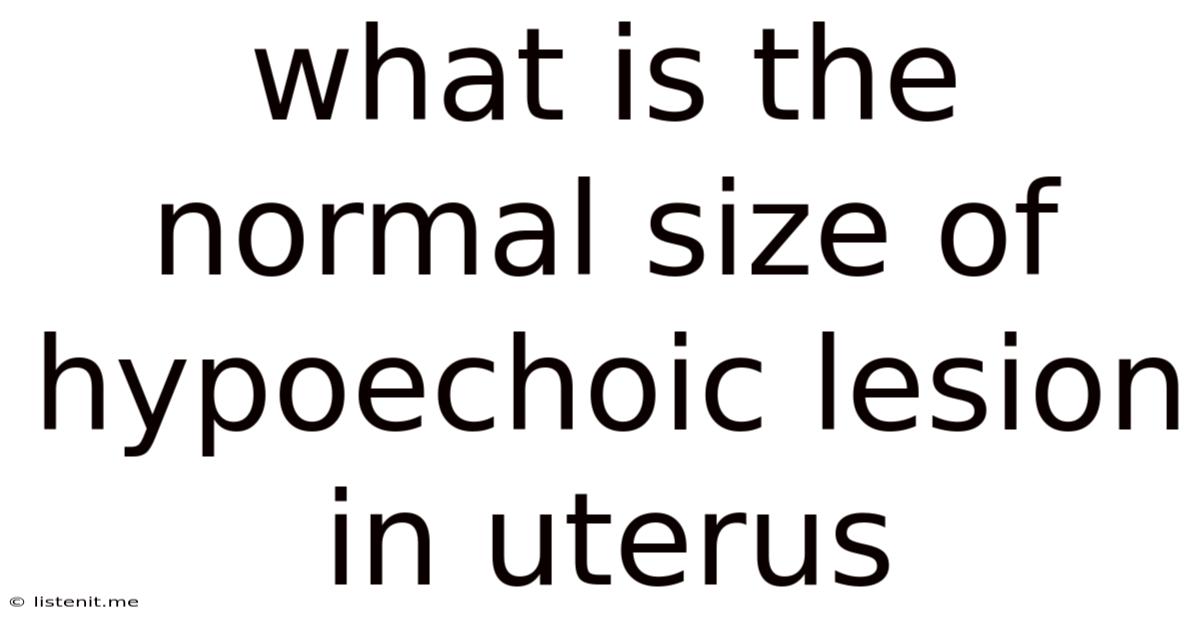What Is The Normal Size Of Hypoechoic Lesion In Uterus
listenit
Jun 12, 2025 · 4 min read

Table of Contents
What is the Normal Size of a Hypoechoic Lesion in the Uterus?
Understanding uterine lesions, especially those appearing hypoechoic on ultrasound, can be a source of significant anxiety. This article aims to clarify what a hypoechoic lesion is, discuss the normal size range (if applicable), and explain why size alone isn't the definitive factor in diagnosis. We'll explore various factors that influence interpretation and the importance of consulting a healthcare professional for accurate diagnosis and treatment.
Understanding Hypoechoic Lesions on Ultrasound
Before diving into size, let's define the term. In ultrasound imaging, tissues are depicted based on their echogenicity – their ability to reflect sound waves. Hypoechoic refers to areas that appear darker than the surrounding tissue because they reflect fewer sound waves. This doesn't automatically mean something is abnormal; many normal uterine structures can appear hypoechoic. The key is the context – the appearance, location, and associated symptoms.
A hypoechoic lesion in the uterus is simply an area within the uterine wall that appears darker on an ultrasound scan than the surrounding myometrium (the uterine muscle). Many different conditions can cause these hypoechoic areas, ranging from completely benign to potentially serious.
Factors Influencing the Appearance and Size of Hypoechoic Lesions
The size of a hypoechoic lesion is just one piece of the puzzle. Several factors significantly influence its appearance and interpretation:
1. The Type of Lesion:
Different uterine conditions manifest as hypoechoic lesions on ultrasound. These include:
-
Fibroids (Leiomyomas): These are benign tumors of the uterine muscle. While many fibroids appear hypoechoic, they can also be isoechoic (same echogenicity as surrounding tissue) or even hyperechoic (brighter). Size varies enormously, from tiny lesions to very large ones that distort the uterine shape. Size is relevant here, as larger fibroids often cause more noticeable symptoms.
-
Adenomyosis: This condition involves the growth of endometrial tissue (the tissue lining the uterus) into the myometrium. It often appears as a diffuse hypoechoic enlargement of the uterus, rather than a well-defined mass. In adenomyosis, overall uterine size is more indicative than a specific lesion size.
-
Endometrial Polyps: While some polyps appear hyperechoic, others can be hypoechoic. They are typically small and well-defined. Size is a factor in assessing the potential impact of a polyp, with larger polyps possibly associated with increased bleeding.
-
Endometriosis: This condition, where endometrial tissue grows outside the uterus, doesn't always appear as a specific lesion within the uterus itself. However, ultrasound might reveal related findings like cysts or thickened endometrium, which could appear hypoechoic.
-
Cancerous Tumors: While less common, uterine cancers (like uterine sarcoma or endometrial carcinoma) can present as hypoechoic lesions. In suspected cancer cases, size, along with other characteristics, is crucial, but it’s not the sole determining factor.
2. Ultrasound Machine and Technique:
The quality of the ultrasound image depends on the machine's resolution and the skill of the sonographer. A less-powerful machine or less-experienced sonographer might misinterpret a lesion's size or echogenicity. Therefore, the reported size should be considered within the context of the imaging quality.
3. Patient Factors:
A patient's age, menstrual cycle phase, and overall health can influence how a lesion appears on ultrasound. For example, the uterine lining thickens during the menstrual cycle, potentially obscuring or altering the appearance of underlying lesions. This highlights the need for consistent imaging protocols and consideration of patient-specific factors.
The Importance of Context over Size Alone
There's no single "normal" size for a hypoechoic uterine lesion. A tiny lesion might be cancerous, while a large one could be a benign fibroid. Size is merely one aspect of the overall clinical picture. The following factors are equally, if not more, important:
-
Shape and margins: Well-defined, smooth borders often suggest a benign lesion, while irregular margins can raise concerns about malignancy.
-
Internal echotexture: The internal structure of the lesion (e.g., homogeneous vs. heterogeneous) provides clues about its nature.
-
Location within the uterus: The lesion's location relative to the uterine wall and endometrium helps differentiate between different conditions.
-
Associated symptoms: Symptoms like heavy bleeding, pelvic pain, or abnormal vaginal discharge should be considered alongside the ultrasound findings.
When to Seek Medical Attention
If you have an ultrasound showing a hypoechoic uterine lesion, or if you experience any concerning symptoms related to your reproductive health, it is crucial to consult with a gynecologist or other healthcare professional. They will take a complete medical history, perform a physical examination, and interpret the ultrasound findings in the context of your overall health. Additional tests, such as MRI or biopsy, may be necessary for a definitive diagnosis.
Conclusion
A hypoechoic lesion in the uterus is a descriptive term referring to an area of decreased echogenicity on ultrasound. Its size alone cannot determine whether it is benign or malignant. Accurate diagnosis requires consideration of numerous factors, including the lesion's shape, margins, internal echotexture, location, and the patient's medical history and symptoms. Always consult a healthcare professional for proper evaluation and management of any uterine abnormalities. Self-diagnosing based solely on ultrasound reports is dangerous and could delay appropriate treatment. Early detection and appropriate management are key to ensuring optimal health outcomes. Remember, your doctor is your best resource for understanding your individual situation.
Latest Posts
Latest Posts
-
What Is A Lean Mass Hyper Responder
Jun 13, 2025
-
Are Organs Composed Of Multiple Tissue Types
Jun 13, 2025
-
Cyanide Poisoning Vs Carbon Monoxide Poisoning
Jun 13, 2025
-
What Are The Walls Of A Ureter Composed Of
Jun 13, 2025
-
Does Melatonin Make You Lose Weight
Jun 13, 2025
Related Post
Thank you for visiting our website which covers about What Is The Normal Size Of Hypoechoic Lesion In Uterus . We hope the information provided has been useful to you. Feel free to contact us if you have any questions or need further assistance. See you next time and don't miss to bookmark.